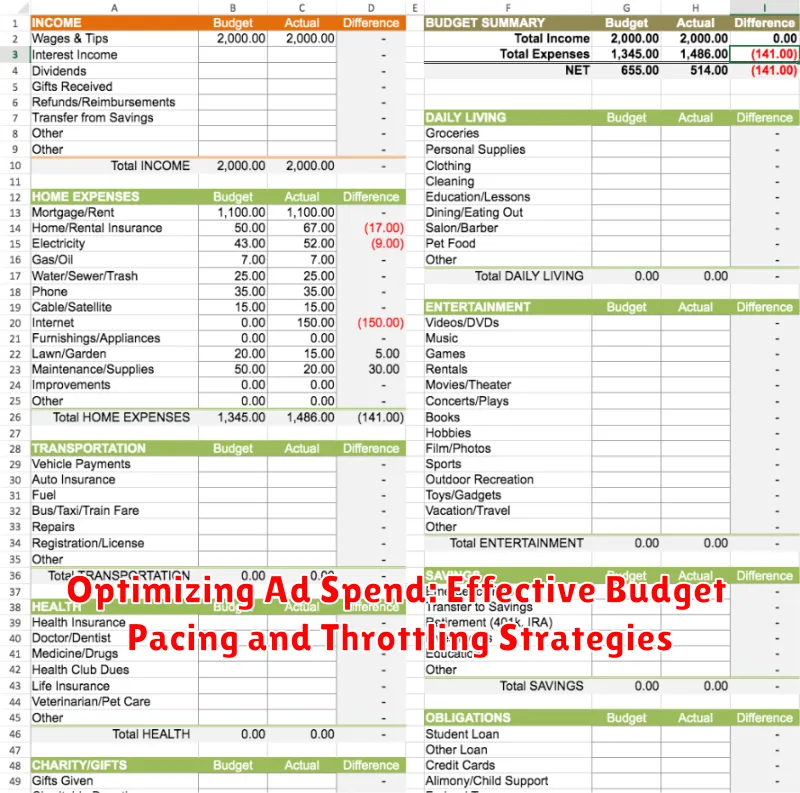In today’s dynamic digital landscape, optimizing ad spend is paramount for businesses striving for sustainable growth and a strong return on investment. Effective budget pacing and sophisticated throttling strategies are no longer optional; they are essential tools for navigating the complexities of online advertising and ensuring every dollar contributes meaningfully to achieving strategic objectives. This article delves into the critical importance of mastering these techniques, providing a comprehensive overview of how to maximize the effectiveness of your ad campaigns.
The ability to control and adjust advertising budgets in real-time is crucial for responding to fluctuating market conditions, competitive pressures, and campaign performance insights. Understanding the nuances of budget allocation, pacing strategies (such as even pacing, accelerated pacing, and dayparting), and throttling methods (including capping bids and setting spending limits) empowers marketers to make data-driven decisions that drive efficiency, minimize wasted spend, and ultimately, achieve superior results. This article explores various practical applications and offers actionable strategies to ensure your ad budget is working optimally for your business.
Understanding Budget Pacing: Delivering Ads Efficiently
Budget pacing is a crucial aspect of digital advertising that focuses on distributing ad spend optimally over a specified campaign duration. Its primary goal is to ensure that the allocated budget is utilized effectively without premature depletion or underspending.
Effective budget pacing allows advertisers to maximize reach, maintain consistent ad delivery, and achieve desired campaign objectives. By carefully managing the rate at which the budget is consumed, advertisers can avoid exhausting their funds early in the campaign, which could lead to missed opportunities during peak conversion periods.
Conversely, inadequate pacing can result in underspending, meaning the full potential of the campaign is not realized. Efficient budget pacing, therefore, serves as a mechanism for optimizing ad delivery, ensuring ads are shown strategically throughout the campaign’s lifespan to capture the most valuable impressions and conversions.
The Importance of Throttling in Campaign Management
Throttling is a critical aspect of campaign management, enabling advertisers to control the rate at which their budget is spent. Its primary function is to prevent the premature depletion of funds, ensuring that campaigns run for the intended duration and achieve optimal results. Without effective throttling, campaigns risk exhausting their budget early, potentially missing out on valuable conversion opportunities.
By implementing throttling mechanisms, marketers can strategically distribute ad impressions and clicks over time, aligning budget expenditure with campaign goals. This is particularly important for campaigns with specific time-sensitive objectives or those targeting audiences with varying online behavior throughout the day.
Furthermore, throttling facilitates the identification of peak performance periods, allowing for budget adjustments that capitalize on high-converting time slots. This refined approach optimizes ad delivery, maximizing return on investment and ensuring sustainable campaign performance.
Types of Budget Pacing: Even, Accelerated, and Dayparting
Budget pacing is crucial for distributing your advertising spend effectively over the campaign duration. Different pacing strategies cater to various campaign goals and require careful consideration. Here are the three primary types:
Even Pacing
Even pacing aims to distribute your budget uniformly throughout the campaign’s lifespan. The system spends a consistent amount daily, ensuring your ads are shown steadily. This strategy is ideal for campaigns focused on brand awareness or sustained lead generation where consistent visibility is key.
Accelerated Pacing
Accelerated pacing spends the budget as quickly as possible. The system attempts to show your ads whenever an opportunity arises, maximizing impressions and clicks within a short timeframe. This approach is best suited for time-sensitive campaigns, such as flash sales or urgent promotions, where rapid reach is paramount.
Dayparting
Dayparting involves scheduling ads to run only during specific times of the day or days of the week. Budget is then paced according to the defined schedule. This tactic allows you to target your audience when they are most receptive to your message, optimizing for conversions and minimizing wasted spend during off-peak hours. For example, B2B companies may only want to run ads during business hours.
Factors Influencing Pacing Strategies

Several factors significantly impact the effectiveness of budget pacing strategies in advertising campaigns. Understanding these elements is crucial for optimizing ad spend and achieving desired outcomes.
Campaign Objectives: The primary goal of the campaign (e.g., brand awareness, lead generation, sales) directly influences the ideal pacing strategy. Aggressive goals often require accelerated pacing, while more gradual objectives may benefit from even pacing.
Target Audience: Audience behavior, including peak activity times and responsiveness to ads, dictates pacing adjustments. Concentrating budget during periods of high engagement can improve campaign performance.
Bidding Strategies: Manual vs. automated bidding strategies impact how quickly budgets are consumed. Automated bidding may require more careful monitoring to prevent overspending, particularly with accelerated pacing.
Ad Inventory and Competition: The availability of ad placements and the intensity of competition within the target market influence ad costs and the speed at which budgets are utilized. High competition may necessitate adjustments to bids and pacing to remain competitive.
Implementing Real-Time Budget Adjustments
Real-time budget adjustments are crucial for maintaining optimal ad spend efficiency. This involves actively monitoring campaign performance and making immediate modifications to the budget based on observed data.
Key Considerations for Real-Time Adjustments:
- Performance Metrics: Closely track CTR, conversion rates, and cost-per-acquisition (CPA).
- Market Dynamics: Respond swiftly to changes in market trends, competitor activities, and seasonal fluctuations.
- Budget Allocation: Reallocate funds from underperforming campaigns to those yielding higher returns.
Effective implementation requires access to a robust analytics dashboard providing up-to-the-minute insights. Set up automated alerts to notify you of significant deviations from expected performance, enabling prompt intervention. For example, if a campaign’s CPA increases dramatically, the budget can be reduced or paused to prevent overspending.
Leveraging Machine Learning for Predictive Pacing
Machine learning (ML) offers sophisticated solutions for predictive budget pacing, enabling advertisers to optimize ad spend with greater precision. By analyzing historical campaign data, ML algorithms can predict future performance trends and adjust pacing strategies accordingly.
This approach goes beyond traditional rule-based pacing by identifying complex patterns and correlations that humans might miss. ML models can consider various factors such as seasonality, competitor activity, and real-time user behavior to dynamically adjust bids and budget allocation.
Key benefits of leveraging ML for pacing include:
- Improved Return on Investment (ROI) through efficient budget utilization.
- Reduced ad waste by preventing overspending on underperforming segments.
- Enhanced ability to scale campaigns effectively.
By implementing ML-driven pacing, advertisers can proactively manage their budgets and achieve optimal campaign performance.
Setting Optimal Throttling Limits to Maximize ROI
Throttling limits are crucial for maximizing return on investment (ROI) in advertising campaigns. Setting these limits involves carefully balancing ad delivery with budget consumption.
Determining Appropriate Limits
The process of determining appropriate limits should be based on a thorough analysis of historical data and campaign goals. Consider factors such as:
- Conversion rates: Lower conversion rates may warrant stricter throttling to avoid wasteful spending.
- Cost per acquisition (CPA) targets: Throttling can help maintain desired CPA levels.
- Daily budget: A smaller daily budget might require more aggressive throttling.
ROI Impact
Optimally set throttling limits directly contribute to a higher ROI by preventing excessive ad spend on underperforming segments or time periods. Regular monitoring and adjustment are essential for maintaining optimal performance.
Avoiding Overspending: Best Practices for Budget Control
Maintaining meticulous budget control is paramount in preventing overspending within advertising campaigns. Implement the following best practices to ensure optimal resource allocation and ROI.
Establish Clear Budget Parameters
Define specific, measurable, achievable, relevant, and time-bound (SMART) goals for each campaign. Set a maximum daily or lifetime budget limit that aligns with these objectives. Consistently monitor spending against these parameters.
Implement Alert Systems
Configure alerts to notify you when campaigns approach predefined budget thresholds (e.g., 75%, 90%). This proactive approach allows for timely intervention and adjustments.
Regular Performance Reviews
Conduct routine performance analyses to identify underperforming ads or keywords. Reallocate budget from these areas to more effective strategies. Consider pausing campaigns that consistently fail to meet predefined KPIs.
Utilize Budgeting Tools
Leverage platform-specific budgeting features and third-party tools to automate budget allocation and monitoring. These tools often provide advanced capabilities such as predictive budgeting and anomaly detection.
Monitoring and Analyzing Pacing Performance
Monitoring and analyzing pacing performance are crucial for ensuring that ad campaigns are effectively utilizing the allocated budget and achieving the desired results. This involves regularly tracking key metrics and making data-driven adjustments to optimize campaign performance.
Key Metrics to Monitor
Several key metrics should be continuously monitored to assess pacing performance:
- Spend Rate: The rate at which the budget is being consumed.
- Impression Delivery: The number of impressions served over time.
- Click-Through Rate (CTR): The percentage of impressions that result in clicks.
- Conversion Rate: The percentage of clicks that result in conversions.
- Cost Per Acquisition (CPA): The cost of acquiring a customer or conversion.
Tools and Techniques for Analysis
Utilize analytics dashboards and reporting tools provided by ad platforms to visualize and analyze pacing data. Implement A/B testing to evaluate the impact of pacing adjustments on campaign performance. Regularly generate reports to identify trends and anomalies in pacing behavior. Analyze performance data across different segments (e.g., demographics, devices, locations) to identify areas for improvement.
Advanced Throttling Techniques for Complex Campaigns

Complex advertising campaigns, often involving multiple channels, target audiences, and creative variations, necessitate sophisticated throttling strategies. These techniques go beyond simple daily or hourly limits, focusing on granular control to maximize campaign performance.
Advanced Throttling Methods
- Audience Segmentation Throttling: Adjusting spend based on the performance of different audience segments. For instance, decreasing bids for underperforming segments while increasing them for high-converting groups.
- Creative Rotation Throttling: Prioritizing ad delivery for creatives with higher click-through or conversion rates. This ensures that the most effective messages are displayed more frequently.
- Contextual Throttling: Modifying bids and spend based on real-time environmental factors, such as device type, location, or even weather conditions.
Considerations for Implementation
Implementing advanced throttling requires careful monitoring and analysis. A/B testing various throttling parameters is crucial to identify the optimal settings. Furthermore, integrating with robust analytics platforms enables real-time performance tracking and data-driven adjustments.

